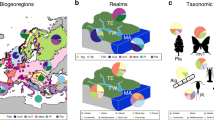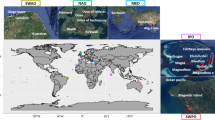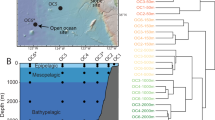Abstract
Arising from: X. Irigoien, J. Huisman & R. P. Harris Nature 429, 863–867 (2004); see also reply from Irigoien et al. In their analysis of global trends of diversity in marine plankton, Irigoien et al.1 find that taxonomic diversity of zooplankton (consumer) is a unimodal function of community biomass that is unrelated to phytoplankton (producer) diversity. Their results are unexpected because in terrestrial organisms primary-producer diversity is a good predictor of consumer diversity2. I contend that this apparent uncoupling of producer and consumer diversity in marine plankton is likely to be an artefact due to the authors' use of different measures of diversity for producers and for consumers.
Similar content being viewed by others
Main
The relationships described by Irigoien et al.1 between phytoplankton and zooplankton diversity on a global scale were based on analysis of 100-ml samples examined in an inverted microscope. This method is commonly used for species identification and abundance estimates of phytoplankton, although it underestimates the diversity of small (<10 µm) species3. For zooplankton, the same method can furnish estimates only of the diversity of easily distinguishable morphotypes, not of species.
The sample material examined by Irigoien et al.1 had been fixed with either Lugol's solution or gluteraldehyde, which in the case of microzooplankton allows reliable species identification in only a very small fraction of cells — namely those with a distinct gross morphology, such as tintinnid ciliates, radiolarians and foraminifera that have ‘shells’ or skeletons: these identifiable forms generally represent some 5–10% of the community. For most ciliates and dinoflagellates, identification is, at best, limited to the genus4. This fixation method is useful for biomass estimations, enabling ciliates and dinoflagellate cells to be placed in size–shape categories; however, these may or may not have ecological relevance and are unlikely to be of any taxonomic validity.
Moreover, Irigoien et al.1 analyse very different population sizes, which might also bias their diversity estimates. Producer and consumer diversity were examined in the same sample, which had relatively few consumers: in 100 ml of surface water, phytoplankton cells number 103–104, compared with 1–102 microzooplankton cells. This explains in part why microzooplankton diversity was positively related to biomass or numbers of individuals, and also why a total of only 43 ‘species’ of microzooplankton were encountered in this global study. This number is low; large volumes from a single sampling site can yield 39 species of a numerically minor component of tintinnid ciliate microzooplankton5.
I therefore propose that the data presented by Irigoien et al. show a weak relation not between taxonomic diversity of consumers and producers but between the size diversity of consumers and taxonomic diversity of producers. Although there could be a correspondence of diversity in producers and consumers if appropriate estimation measures were to be used, this remains to be investigated.
References
Irigoien, X., Huisman, J. & Harris, R. P. Nature 429, 863–867 (2004).
Morin, P. J. & Fox, J. W. Nature 429, 813–814 (2004).
Hasle, G. R. in Phytoplankton Manual (ed. Sournia, A.) 125–128 (UNESCO, Paris, 1978).
Gifford, D. J. & Caron, D. A. in Zooplankton Methodology Manual (eds Harris, R. P., Weibe, P. H., Lenz, J., Skjoldal, H. R. & Huntley, M.) 193–221 (Academic Press, London, 2000).
Cariou, J.-B., Dolan, J. R. & Dallot, S. J. Plank. Res. 21, 1065–1075 (1999).
Author information
Authors and Affiliations
Corresponding author
Rights and permissions
About this article
Cite this article
Dolan, J. Different measures of biodiversity. Nature 433, E9 (2005). https://doi.org/10.1038/nature03320
Published:
Issue Date:
DOI: https://doi.org/10.1038/nature03320
This article is cited by
-
Microeukaryote Diversity in a Marine Methanol-Fed Fluidized Denitrification System
Microbial Ecology (2008)
-
Probing Diversity in the Plankton: Using Patterns in Tintinnids (Planktonic Marine Ciliates) to Identify Mechanisms
Hydrobiologia (2006)
-
Different measures of biodiversity (Reply)
Nature (2005)
Comments
By submitting a comment you agree to abide by our Terms and Community Guidelines. If you find something abusive or that does not comply with our terms or guidelines please flag it as inappropriate.



